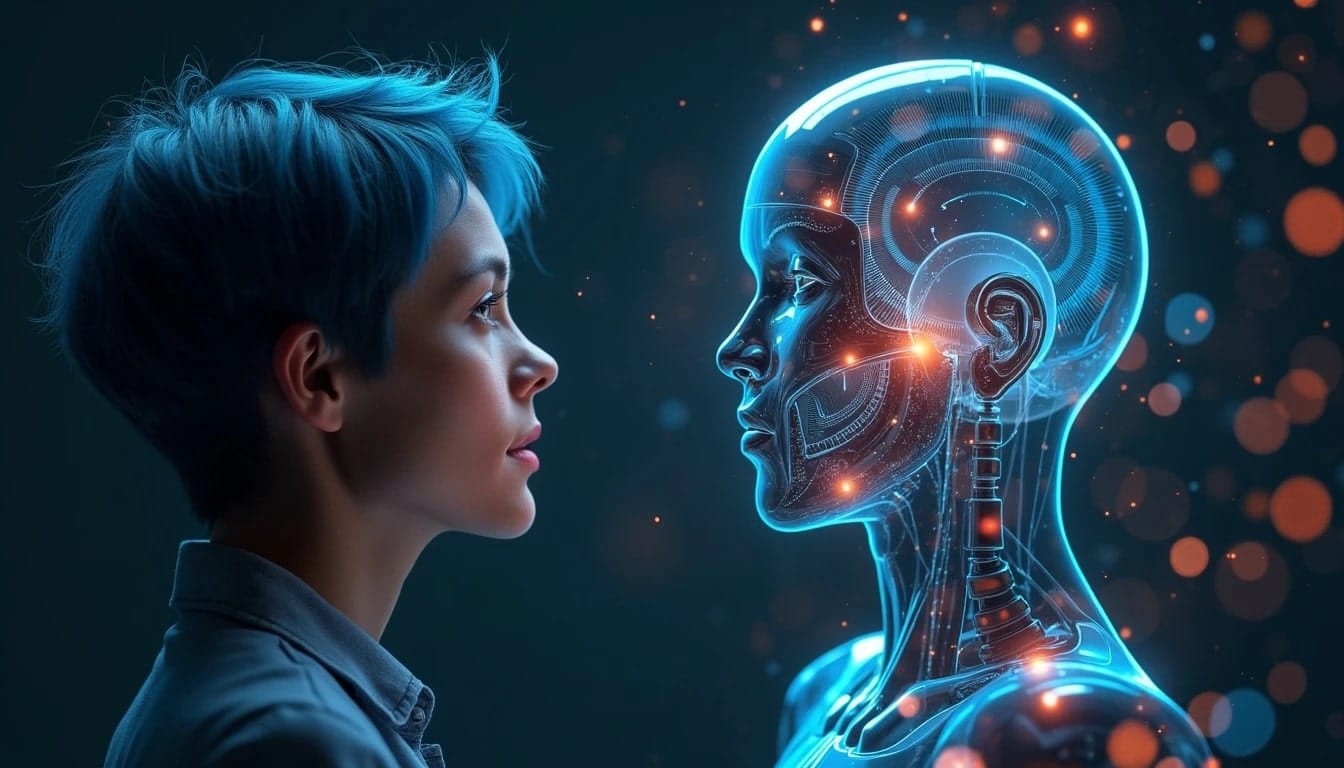In the growing dialogue between humanity and artificial intelligence (AI), the evocative image of a young woman and an advanced humanoid robot stands as a powerful symbol of the potential and tensions inherent in this emerging relationship. This portrayal of a close encounter between both beings not only underscores technological progress but also raises critical questions about the nature of our coexistence with machines.
The image features a woman with short blue-tinted hair facing off against a robot with a sleek, translucent design, where illuminated circuits and neural connections emerge as a visual testimony to the sophisticated technological level achieved. The intensity of the shared gaze between both characters, along with the futuristic and ethereal atmosphere created by floating orbs of light, suggests a deep and symbolic connection between human and artificial intelligence.
However, beyond the aesthetic appeal of this representation, it is crucial to examine the reality of this “human-digital harmony” that the image idealizes. The scenario presented, though fascinating, could be seen as a utopian vision that overlooks the real complications and challenges that arise from the integration of AI into everyday life.
### The Beauty of Futurism vs. The Harsh Reality
The image is undoubtedly a testament to the impressive technological capacity we have achieved. The vision of a robot with visible circuits and pulsating lighting is not only visually striking but also reflects the significant advances in robotics engineering and AI. The image captures the essence of what many in the technological field aspire to: a seamless and enriching integration between humans and intelligent machines.
However, the beauty of futurism posed by the image may distract from critical and tangible issues that are part of current reality. The coexistence between humans and robots raises questions about ethics, privacy, and the nature of work. The idealization of a perfect connection between a human and a machine is advancing at a pace that often does not align with AI’s current ability to understand and respond to genuine human emotions.
### Ethical and Social Challenges
The representation of a harmonious and understanding relationship between humans and robots contrasts with the ethical concerns that arise in real life. As AI becomes more integrated into society, debates emerge about privacy, algorithmic bias, and the impact on employment. The ability of AI to mimic human behaviors does not mean it can understand or experience emotions in the way humans do. This raises questions about the extent to which we can or should allow AI to interfere in deeply personal and emotional aspects of our lives.
Moreover, the growing dependence on AI may exacerbate existing inequalities rather than mitigate them. The vision of a harmonious and empathetic connection between humans and robots does not address disparities in access to advanced technologies or the consequences of their unregulated implementation in the labor market.
### The Need for Open Dialogue
Instead of idealizing a perfect fusion between humans and machines, it is crucial to address the reality of these technologies with a balanced and critical approach. The beauty of the evocative image must be accompanied by an open dialogue about the practical and ethical implications of AI. It is essential for developers, policymakers, and society at large to collaborate to ensure that technological advancement is not only impressive aesthetically but also responsive to human needs and respects our fundamental values and rights.
The human-digital harmony, as presented in this image, may be a valuable aspiration, but it must be viewed through the lens of a critical and realistic evaluation. Only through a deep and conscious understanding of the capabilities and limitations of AI can we build a future in which technology and humanity coexist equitably and enrichingly.
Ultimately, striking a balance between admiration for technological advances and critical reflection on their implications will be key to achieving true harmony in the digital age.

